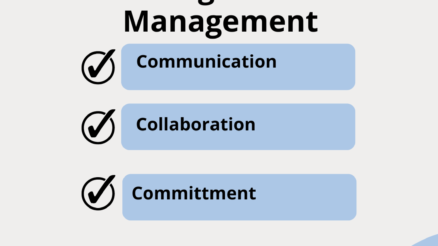Organizational change aims to transform businesses, processes or technologies but it all strats with the first step in change management.
This initial phase is pivotal, as it sets the tone for a successful and smooth transition, paving the way for your organization’s continued development and prosperity.
This blog post explains importance of this first stage, its challenges, and how it forms the foundation for effective change management.
This post provides valuable insights to every change leader, manager or professional who is associated in one or other way with implementing change. So, whether you are a seasoned professional or a keen learner who is interested in learning about change management, this post is tailored for you.
Let’s dive in and start reading
What is Organizational Change?
Organizational change refers to the process by which organizations undergo transitions to achieve new business goals, adapt to market changes, or improve performance and productivity.
It encompasses a wide range of activities, from minor procedural adjustments to major shifts in business strategy or company culture.
This change can be driven by various factors such as technological advancements, competitive pressures, changes in consumer preferences, regulatory changes, or internal organizational challenges like declining performance or employee dissatisfaction.
At its core, organizational change involves redefining an organization’s operations, strategies, structures, and processes.
This can include implementing new technologies, restructuring the organization, introducing new processes or business models, or shifting the organizational culture.
Effective change management is critical in these scenarios, as it ensures a smooth transition from the current state to the desired future state while minimizing disruptions to operations and mitigating resistance from employees.
Ultimately, the success of organizational change hinges on careful planning, clear communication, and ongoing support throughout the transition process, ensuring that the changes are not only implemented but also accepted and integrated into the organization’s fabric.
First Step in Change Management: identifying the need of Change
Identifying the need for change is fundamentally the first step in the change management process, serving as the cornerstone for all subsequent actions.
This initial phase involves recognizing that the current state of an organization is not optimally aligned with its market environment, goals, or potential growth opportunities. It’s about understanding that change is not just an option but a necessity for progress and sustainability.
This realization often stems from various internal and external factors. Internally, it might be triggered by issues like declining performance metrics, operational inefficiencies, or workforce dissatisfaction.
Externally, factors such as evolving market trends, technological advancements, or competitive pressures can necessitate change.
It’s a stage where the organization takes a critical look at itself, assessing its current position and how it aligns with its long-term objectives and industry standards.
Once the need for change is identified, the organization then needs to articulate and define what this change entails and why it’s imperative.
This involves setting a clear vision of what the organization aims to achieve through change and aligning this vision with its overall mission and values. It’s not just about recognizing the problems or challenges but also about visualizing a future state where these issues are addressed.
Communicating this need and vision effectively is crucial to garner support and buy-in from stakeholders at all levels – from top management to the operational staff. It sets the stage for a smoother transition, as it helps in managing expectations, reducing resistance, and fostering a culture of adaptability and openness to change.
In essence, identifying the need for change is the spark that ignites the entire change management process, guiding the direction and strategy of the transformation efforts.
Learn more about: 15 Key Steps in Change Management
Why is important to identify need of the change ?
Identifying the need for change is not just about fixing problems as they arise; it’s about taking a proactive stance in guiding the organization towards sustainable growth and success.
It’s a critical step in ensuring that change initiatives are meaningful, strategic, and aligned with the organization’s long-term objectives
- Recognizing the need for change allows organizations to allocate resources more effectively. By identifying areas that require improvement or transformation, organizations can prioritize investments in technology, training, and development. This focused allocation of resources prevents wastage and ensures that efforts are directed towards areas that yield the most significant impact.
- Engaging employees in the change process from the beginning, by identifying and communicating the need for change, can increase their commitment and reduce resistance. When employees understand why change is necessary and how it can benefit the organization and themselves, they are more likely to support and participate actively in the change process.
- Regularly assessing the need for change fosters a culture of continuous improvement within the organization. It encourages a mindset where employees are always looking for ways to improve processes, products, and services, leading to ongoing enhancements in efficiency, quality, and customer satisfaction.
- Identifying the need for change is essential for long-term organizational success and growth. It ensures that the organization does not become stagnant or complacent but continues to evolve and adapt in response to internal and external pressures.
10 Signs that Indicate a Need for Change
Recognizing the signs that indicate a need for change is essential for timely and effective organizational transformation.
Here are ten signs, each explained in detail:
1. Declining Performance Metrics:
A clear indicator of the need for change is a consistent decline in key performance indicators such as sales, profitability, customer satisfaction scores, or productivity levels. This decline often suggests inefficiencies or outdated practices that need to be addressed. It’s essential to analyze these metrics over time to distinguish between temporary downturns and long-term trends.
2. High Employee Turnover:
When an organization experiences a high rate of employee turnover, especially of its top talent, it often signals underlying issues such as poor management, lack of career development opportunities, or unsatisfactory working conditions. High turnover not only affects morale but also increases training and recruitment costs, impacting the organization’s overall performance.
3. Market Share Loss:
Losing market share to competitors is a critical sign that an organization may be falling behind in innovation, customer service, or market understanding. This could be due to outdated products, poor marketing strategies, or failing to keep up with market trends and consumer preferences.
4. Customer Complaints and Feedback:
An increase in customer complaints or negative feedback can indicate problems with product quality, customer service, or user experience. This sign is particularly important as it directly reflects the organization’s ability to meet customer needs and expectations.
5. Employee Disengagement:
Signs of employee disengagement, such as lack of enthusiasm, low participation in meetings, or a decline in productivity, can suggest that employees are not feeling valued or motivated. This can stem from a variety of issues, including poor communication, lack of recognition, or misalignment with the company’s vision and goals.
6. Technological Obsolescence:
Falling behind in technology can put an organization at a significant disadvantage. This can manifest as outdated software systems, inefficient manufacturing processes, or lack of data analytics capabilities. Keeping pace with technological advancements is essential for efficiency, innovation, and competitiveness.
7. Regulatory or Compliance Issues:
Encountering legal or regulatory compliance issues can necessitate organizational change. Changes in laws, regulations, or industry standards may require process adjustments, new compliance measures, or even changes in product or service offerings.
8. Changes in Leadership or Ownership:
New leadership or changes in ownership can bring different perspectives and strategies to an organization. This can prompt a reevaluation of current practices and potentially necessitate changes in direction, culture, or operational practices.
9. Ineffective Processes and Systems:
Signs of inefficiency, such as prolonged project timelines, redundant processes, or excessive bureaucracy, indicate a need for process improvement. Streamlining operations can lead to significant gains in efficiency and productivity.
10. Shifts in Industry Trends or Consumer Behavior:
An organization must adapt to shifts in industry trends and consumer behavior to stay relevant. Failure to adapt can lead to products or services becoming outdated. Keeping a finger on the pulse of the industry and evolving consumer preferences is vital for continual growth and relevance.
The next steps following the identification of Need for Change
Assessing Readiness for Change:
Assessing the organization’s readiness for change is a critical step. This includes evaluating the organization’s current capacity to handle change, including resources, infrastructure, and the skills and attitudes of employees. It also involves gauging the level of support from key stakeholders and leadership. This assessment helps in determining whether the organization is presently equipped to undertake the change or if there are areas that need to be developed or strengthened first.
Read more about: Change Readiness
Developing a Change Proposal:
Based on the findings from the analysis, performance gap identification, root cause analysis, and readiness assessment, the next step is to develop a change proposal. This proposal should outline the identified need for change, the objectives of the change initiative, the expected benefits, and the preliminary approach for implementing the change. It should also include an initial risk assessment and strategies for managing potential resistance.
Seeking Approval and Building Consensus:
The final step involves presenting the change proposal to decision-makers and key stakeholders to seek approval and build consensus. Effective communication is essential here, as stakeholders need to understand the rationale behind the need for change and how it aligns with the organization’s overall strategy and goals. Gaining their support and commitment is crucial for the successful initiation of the change process.
Final Words
In conclusion, the first step in change management, which involves identifying the need for change, is undeniably pivotal in setting the course for successful organizational transformation. This crucial step not only lays the groundwork for strategic planning and implementation but also ensures that the change is relevant, timely, and aligned with the organization’s overall objectives. It requires a keen awareness of both internal dynamics and external market forces. This first step is more than just a preliminary phase; it’s a strategic move towards sustainable growth and continued success in an ever-changing world



